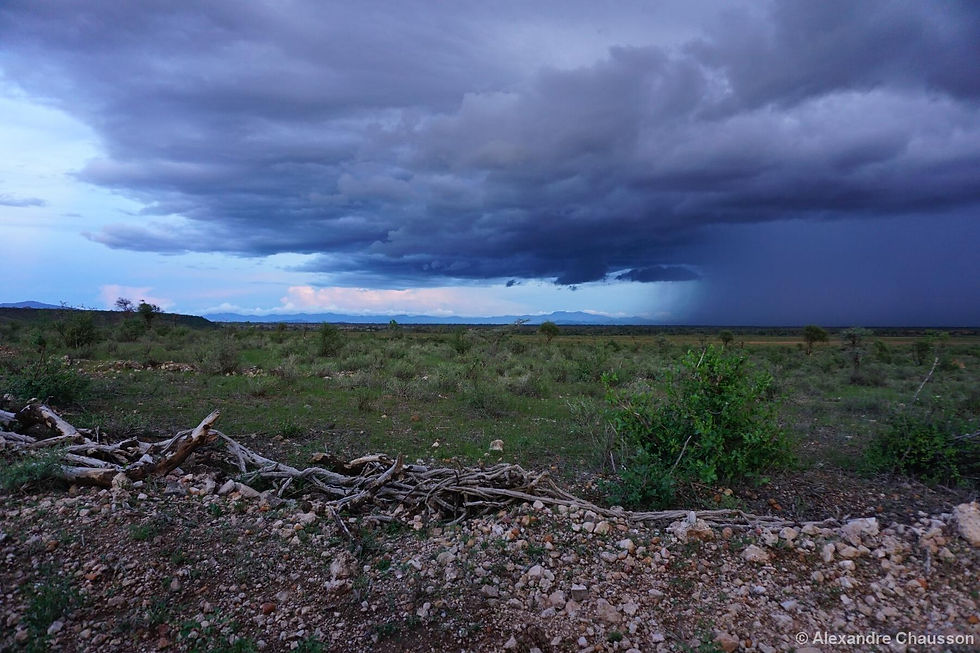NEW RAINS, GRASS, AND BULLS IN MUSTH
- Alexandre Chausson
- Apr 19, 2015
- 3 min read
This blog is featured in Among The Elephants - SaveTheElephants.org
It is now mid-April, and aside from the previous dry weekend, the rain has finally maintained a steady presence. The rain has come primarily in the form of storms, but the landscape has also been blessed by several periods of continuous rain sometimes lasting through the night. A case in point - a thick cover of clouds took over the area yesterday and the temperature dropped significantly in the process before the rain started. Heavy downpours today have filled crevices in the roads with rain. It is the first time that I see uninterrupted clouds all the way into the distance. New blades of grass have finally started to pierce through the dusty orange earth into the Samburu reserve covering the landscape with a green blanket, much like crocuses emerging through spring snow. Just a week ago, before the heavier rains and the restarting of the Ewaso Ng’iro river, the plains were dry and dusty. While the sun is still strong when not hidden behind clouds, the temperature has dropped, and cool breezes are more frequent, refreshing us as we set out on our Long Term Monitoring drives to locate and observe elephants. In comparison with the scorching temperatures I encountered in the South Rift during the long dry spell in March, and, from what I hear, the temperatures in Samburu at the same time, the difference is significant.

The importance of grass in this arid landscape cannot be understated, as it is the life source for both wild animals, and cattle. Nutrients locked up in the arid soil are finally available to the multitude of grazers inhabiting the plains, feeding new energy back into the food chain. Those which do not succumb to water and food shortages have a chance to build new reserves. A week after spotting Nikki and her new calf, we encounter the pair once again. The artist family, which they are a part of, is feasting on tasty Acacia elata, and new grass blades beneath the foot of the trees in old sierra fort, one of their favorite areas. The new rains, and new grass have attracted larger aggregations of elephants. Some families previously seen on their own for the past two weeks are now seen in association with others, and elephants appear to be significantly more active. I am anxious to see these larger aggregations become a common occurrence as the wet season kicks into full gear.

While I have had many encounters with elephants in the field these past two weeks, nothing could have prepared me for my first encounter with a male in musth. When in musth, male elephants produce a large increase in reproductive hormones and adopt a more aggressive behavior. A nearly continuous dribble of urine discharge is clearly visible, as well as swollen temporal glands which discharge a stream of liquid. Two large bulls in musth, Daud and Ndeki, were spotted on the Samburu side of the reserve within thirty minutes of each other. About ten minutes after leaving camp a few days ago, Daud suddenly emerges from thick bush, advancing with determination in the opposite direction. We approach carefully to avoid disturb him and he ends up right next to our vehicle. What an exhilarating experience it is to have a bull in musth tower above me! He quickly loses interest in the car and carries on his way. Ndeki who we spot shortly after in the distance, is equally impressive, and has a distinctive scar on the skin covering his left tusk.


We leave the bulls in peace to reach the Artists 2 and the Poetics 2 who are mingling with each other, followed by the Flowers, and the American Indians, amongst whom Ute, with her splendid tusks, is happily chewing on fresh acacia leaves as young ones in the group happily splash around in a mud hole.




















Comments